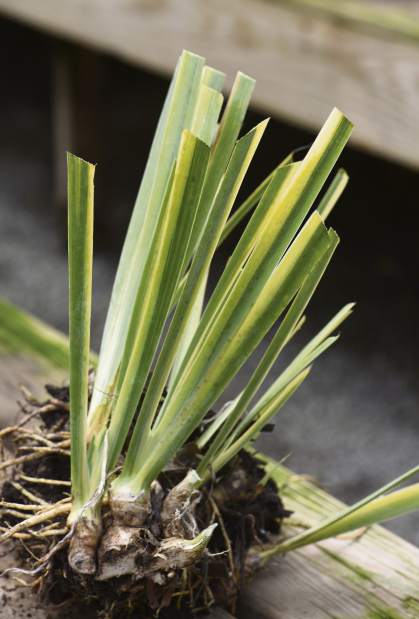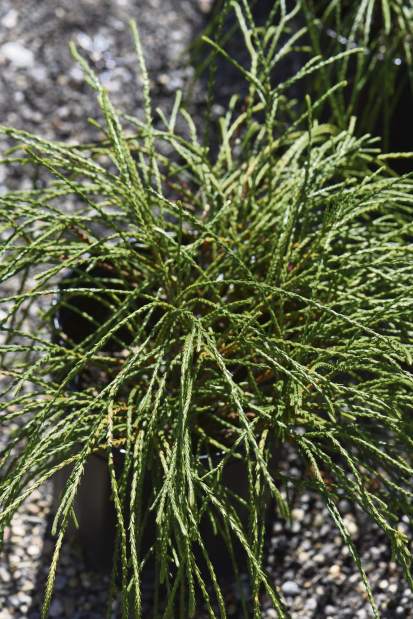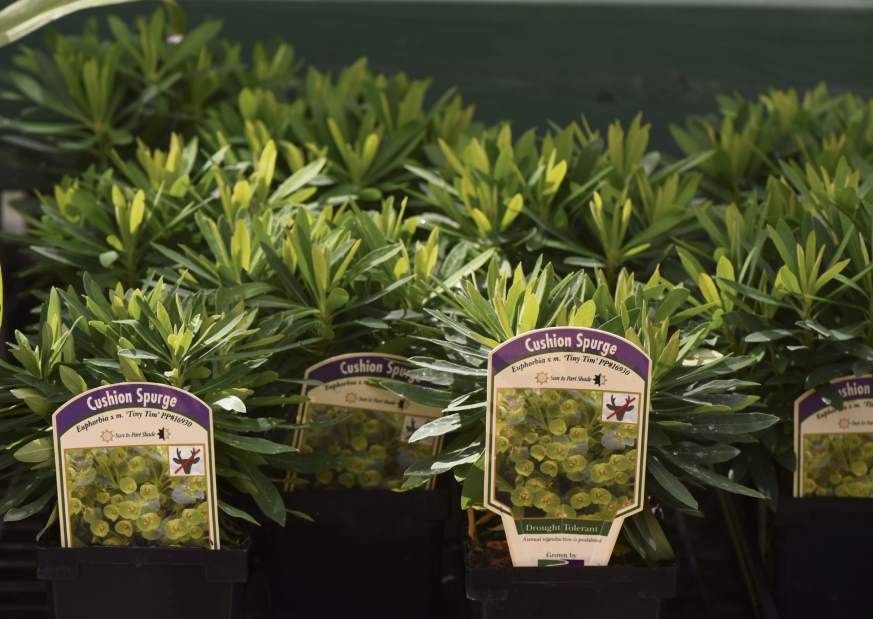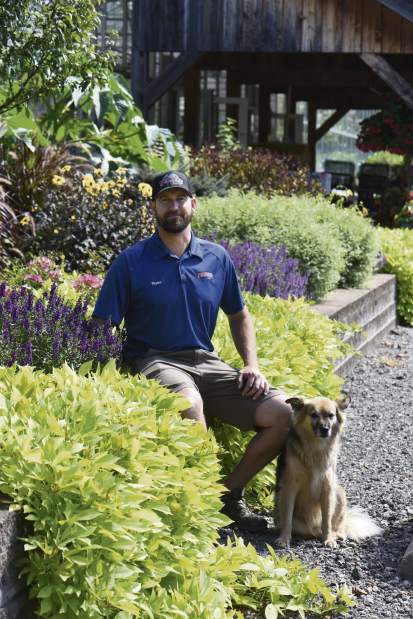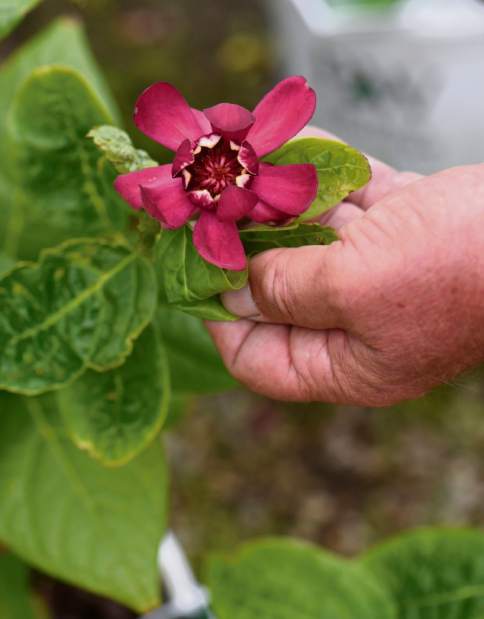Nursery owners reveal their favorite underused plants
It's obvious Russ Bedner is a people person. He laughs easily while talking to customers as he helps them find the right plant.
The 38-year owner of Bedner's Farm and Greenhouse in McDonald has spent most of his life in the business. He is the inspiration for this story, talking about plants he loves but that gardeners might not have discovered yet.
Bedner sits inside a wooden gazebo looking down at a little piece of paper with his scribbled notes. His first suggestion for gardeners is a small shrub called Thuja plicata ‘Whipcord.'
“It looks like ropes growing out of it,” he says of the relative of arborvitae. It grows 4 to 5 feet tall and wide with a mounding habit. “You have to see it,” he says. “That's a really unique plant.”
There's a row of beautiful yellow Ilex ‘Drops of Gold' along a gravel path in the greenhouse. The evergreen plant is 4 to 5 feet tall and wide, a sun lover and tough, too, because it's a holly.
“Another great thing: It's easily shaped if you want to keep it smaller, round or prune into a hedge,” he says. “The more sun you put it in, the better.”
Anemone ‘Pocahontas' has double pink blossoms and gets only about 2 feet tall.
“It's an awesome-looking flower,” Bedner says. “It blooms later in the season. There aren't a lot of late-flowering perennials.”
It will thrive in sun or part shade and is drought-tolerant. Getting this plant and most others off on the right foot is critical to their success.
“When you first plant them, get them established well,” he says. “Give them water and a little TLC to start off with.”
One of the joys of his business is meeting with customers to create something special for their landscape.
“Getting them to know the different plants and options that they have, it's fun,” Bedner says. “You can actually teach them along the way. It's fun to help them succeed in what they want their house to look like.”
He's known may of those customers since childhood.
“You get to know them by their first name,” he says with a smile. “It's like a friend.”
Perennial euphorbia is another plant he guides his customers toward.
“It's one of my favorites,” he says. “They come in all different colors and heights; one in particular is ‘Tiny Tim.' The flower on it is amazing. It gets a cluster of flowers that almost look like buttercups in the spring.”
Pulmonaria is another favorite. “It's more of a shade-loving plant,” he says. “It has a very nice variegated leaf, then it gets a purple flower.”
Another shade or part-sun plant is heuchera.
“I like ‘Palace Purple',” he says. “It's one of the older varieties, but the color and the veining in the leaves is very nice.”
Bedner is also focusing on pollinator plants as part of the Million Pollinator Garden Challenge, a campaign to register a million public and private gardens and landscapes that support pollinators.
“One in three bites of food comes from a pollinator,” he says. “That is very important for our food supply.”
Ratibida columnifera, or Mexican hat plant, is a native that grows about 2 feet tall and has small flowers he describes as a cross between black-eyed Susans and coneflowers. “The birds, bees and butterflies all love it,” he says.
Kalimeris incisa ‘Blue Star' is another native. It produces pretty asterlike flowers from June until September and grows nearly 18 inches tall.
“If you shear it back after the initial bloom, you'll get a rebloom later in the season,” Bedner says.
Bedner is driven to sell plants that are good for both gardener and environment.
“That's one of our main goals here,” he says. “You want to supply not only a nice a garden for your customers, you want to be involved with your surroundings, too — knowing that you're helping it to thrive.”
Chapon's Greenhouse, Baldwin
Pete Chapon has a cardboard box filled with a plant he just dug out of his wife Lori's garden. The owner and manager of Chapon's Greenhouse in Baldwin had a little explaining to do as he told her he was giving one of his treasured irises to me.
“One of my all-time favorite plants is the zebra iris (Iris pallida),” he says. “I like it for two reasons. You get a real nice flush of blooms in the spring — light purple, and the foliage is variegated. It's not the green and white that you typically see. It's green and gold with a large gold stripe on it.”
He's been part of the nursery since his parents started it 44 years ago and has seen plants come and go. There are still customers shopping here who have returned season after season from their first year in business. Helping people, he says, is one of the best things about his job.
“You can save them some time and maybe some heartaches, because some plants, they need a little more care. If you can talk to the customer and see what they are trying to accomplish with the plants, you can make some nice recommendations.”
The greenhouse is still filled with mandevillas, one of his favorites. “They've come out with a lot of new colors,” he says.
When he travels to trade shows, Chapon doesn't need to worry about watering the plant, as the waxy leaves are able to stand some drought conditions. The plant can also be grown indoors all winter long in front of a large picture window or sliding glass door.
Trailing and hybrid portulaca are also on his list of plants that are nearly indestructible.
“I like them both because they don't need much water,” he says. He's also had good luck with the trailing type that's self-sowing.
In his own garden, Chapon uses grasses, smaller pennisetum types to make a nice display and taller miscanthus varieties for the back of the border. He loves zebra grass and Japanese variegated varieties and counts ‘Morning Light' as one of his favorites.
“I never water them,” he says. “You only have to prune them once a year.”
He cuts his down in the spring because he enjoys the show they put on as they sway in the cold breezes of winter. It's one plant that he can reliably say is deer-proof.
The only dayliles he'll recommend are the reblooming varieties. He likes to mass one color for big impact in a bed.
“They have a big flush in the spring and periodic blooms for the rest of the season,” he says. “If you don't deadhead them, you won't get a lot of reblooms.”
‘Stella de Oro' might be the most popular with it's pretty yellow blooms, but there are other colors, including ‘Purple de Oro,' which is just a bit taller than its cousin.
Organic fall vegetables are started by seed here and the greenhouse benches are filled with fresh lettuce, Swiss chard, cole crops and more.
“You can't put a garden in without kohlrabi,” he says with a laugh.
‘Lutz' beets will get to be the size of a softball and can stay in the ground most of the winter under a thick layer of mulch.
“We've been trying to get people to realize they can put more crops in now,” he says.
Quality Gardens, Valencia
It's always nice to be greeted by a friendly dog when arriving at Quality Gardens in Valencia. President Tom McMeekin is thrilled go over the plants he hopes customers will grow in their gardens. The first on his list is a cool native shrub: Buttonbush.
“There's a new variety called ‘Sugar Shack' that gets to be about 3 feet tall and across,” he says. “It has those very nice Sputnik-like flowers that occur later in the summer. They are white and fade to pink.”
It's a sun lover, very adaptable and easy to grow.
Abelia ‘Ruby Anniversary' and ‘Sweet Emotion' are a couple more favorites.
“They bloom in late spring with a nice rosy, white flower. This plant needs rich, loamy soil to thrive. The better you treat it, the better it will treat you,” he says with a smile.
Aronia, or chokeberry, is a native. The standard plant gets 6 feet tall, which might be a little big for many gardens.
“‘Low Scape' (Hedger) only gets about 3 feet tall,” McMeekin says. “They really come into their own in fall when the leaves start to change and the berries start to stand out. Birds love the berries.”
There's one plant that stands above all the rest, as far as this nurseryman is concerned.
“If I were to pick one out of all of them, it's sweetshrub Calycanthus (floridus); the variety specifically is called ‘Aphrodite.' No one's heard of it.”
He likens it to a dwarf, reblooming magnolia with red flowers that smell like “heaven.”
He makes a case for rose of Sharon.
“There's some wonderful new varieties. The colors are spectacular, the flower form being doubles now — very nice,” McMeekin says.
He loves the Chiffon series that come in blue, lavender, pink and other colors, too.
“The newer varieties carry forward all of the better characteristics,” he says. “The growing in tough places, resistance to any kind of fungal problems — they don't seem to be particularly bothered by any insects. They are just a very tough shrub. I think they are worthy of a second look.”
It was tree and shrub guru Michael Dirr who turned him on to itea ‘Henry's Garnet' and ‘Little Henry.'
“They are one of my favorite underused shrubs,” he says. “Both of them are adaptable to full sun to part sun. Racines of white flowers appear midspring that smell wonderful. The new growth is very vibrant. It's a wonderful harbinger of spring. It grows very manageably into a nice, arching bush.”
Doug Oster is the Tribune-Review home and garden editor. Reach him at 412-965-3278 or doster@tribweb.com. See other stories, blogs, videos and more at triblive.com/lifestyles/dougoster.
Article by Doug Oster,
Everybody Gardens
 http://www.everybodygardens.com
http://www.everybodygardens.com
Copyright © 535media, LLC





